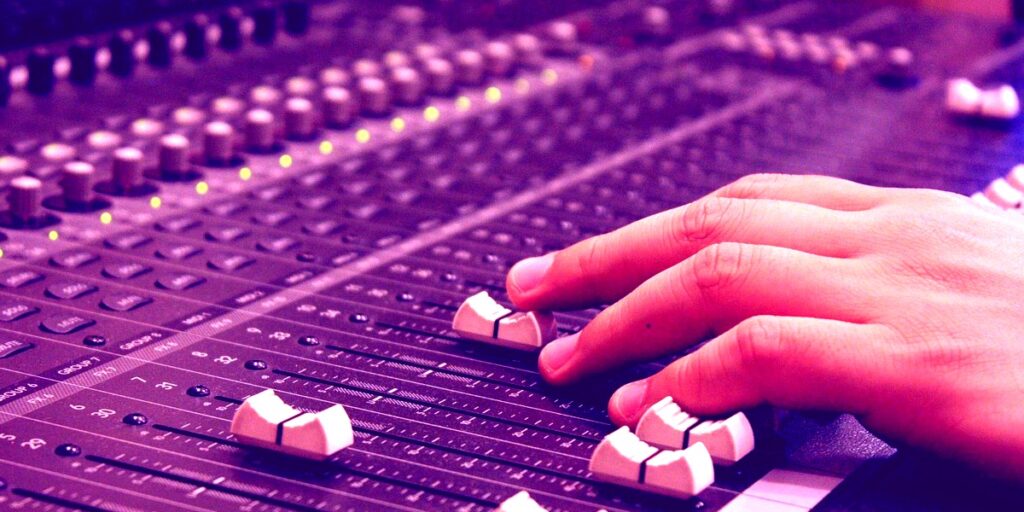Are you afraid to touch what the artist is doing? Do you think you are leaving too big a mark on the mix? Think again!
You ARE serving the song when you react on it in a sonic way. There’s nothing wrong with a purist approach to mixing in my opinion. Many great songs have a very pure sounding mix. Since the early years of recorded music, as technology progressed, the introduction of reverb chambers, tape echo and other studio trickery contributed to the not so “realistic” mix. Where do you draw the line when it comes to realism? Do you mix everything dry with very little EQ? Do you only use one reverb and very little of it? When you ad a reverb, you’re placing the music in a different space. So you are already manipulating the sound in the song’s favor. Is there more to be gained there?
Maybe you are at this point, just before you start mixing a song: The song is great, the performances are really good and the tracks are all recorded well. Now it’s up to you to let the sound of the total mix take the song to the next level. Have you thought about taking the listener to a place? An emotional state. Can you tell where the artist wants to take you? How do you go about this when your other task is to make a “professional” sounding mix.
Of course you make choices about everything. Creative choices, choices about the overall balance, panning choices, EQ choices, cleaning up the bottom end, automating the lead vocals. Where in this process is YOUR connection to the meaning of the song? Is it at the end when you’ve made everything sound “perfect”? Is it at the start when you listen to the song the first couple of times, while making a quick rough mix? Or is it the whole way through your mixing process? Here are some ideas about implementing broad strokes of intuition into your mixes.
Before you start tweaking the sounds
When you hear a really great song for the first time on the radio, your mind processes it all at once and makes a total sum of the listening experience. If you are a musician like me, this isn’t only a quick scan of the used chords, the use of instruments, the form, the rhyme schemes and the amount of bass. The combination of the whole thing coming out of your speakers also creates an emotional reaction. The song is compelling to you. One of the reasons is the sound. The sound is the combination of the performances, the way they are recorded, the mix and the master. So the mix is a part of how you feel after hearing the song.
When you’re about to mix a song yourself, chances are you’ve heard it before, because you wrote it and/or recorded it. When you haven’t heard it before, you are in the same unique position as the listener! You don’t know how good the song is. So first impressions can also tell you a lot about what might be needed to make it a great listening experience.
When you do know the song, it can help to take some time away from the recorded material before you start mixing. This way you are more open to impressions when you play it back again. The first impression will be more like a “oh yeah, I remember this”, combined with some surprising details that you didn’t remember. This is where the opportunity lies for getting intuitive with the impact of the sounds.
Try this the next time you open up a session:
- Make notes during the first few times you listen through the whole track while you make a quick balance mix.
- Pay attention to first impressions.
- Write down keywords that come to mind.
- Listen to the lyrics. What’s the song about? Write it down.
- How does the melody make you feel? Write it down.
- What engages you the most in the song? Write it down.
- What do you immediately feel is lacking? Write it down.
- Try to focus on the big picture and things that stand out in a big way, not the little details at first.
If you do this you’ve got valuable information to create a plan before you’ve done anything to the audio. The things you felt the first times you played the song are written down and you can go back to them to stay on track. Also this provides you with a great starting point to mix the song with a meaning and purpose and you can imagine the end result you are striving for a lot better.
Make a plan
Make a quick plan as in an emotional roadmap for the song. Draw an emotion timeline or a quick graph which indicates where the areas of impact are. This gives you an indication of what to do with the transitions from verse to pre-chorus, from pre-chorus to chorus, from chorus back to verse 2, from chorus 2 to the bridge etc..
You can also draw a plan of the stereo field and how you want to place the instruments in it.
After that start with the most important element. Sometimes this is the lead vocal, sometimes the kick drum. After zooming in on the most important element, I quickly go back to listening to all instruments. I sometimes lose myself in making a killer drum sound, only to be turning it down more and more later when I add more instruments. I also come to the conclusion some drum sounds take too much space in the mix. So it makes sense not to lose perspective on the whole mix.
Look at your emotional roadmap. Think of ways you can make your transitions happen as you’ve drawn them on your graph. For instance going from a verse into a chorus, you might want to go from quiet to loud, or from a few instruments to a lot. You can also think of it in terms of wide and narrow in the stereo field using panning. Or frequency wise with filtered top and bottom, going into full frequency range. Or dry with no reverb or closet reverb, going to very ambient with large hall or cathedral reverb. By doing this you can create big or subtle differences as the song progresses. You can also start to mix the loudest part of the song first and make everything else build up to that. So by the time you get there, the levels really are going to the max, instead of starting out loud and finding yourself with no headroom in the hottest part of the song. These are all parts of your mixing plan that arise directly from your first impressions notes that you took earlier. If you know the shape of the song and how it should feel in every section, that’s your mixing blueprint.
Can you feel it?
While you’re in the process of making the mix work, you can stay focused on how the mix should feel for you. What is necessary to achieve this? Zooming in and out with details and bigger parts and playing the song from front to back going through all the transitions. Glancing back at your initial first notes, is there something that’s not in there yet? What can you think of from the top of your head that will bring this to the mix? Also keep in mind to take breaks! Best practice for me is to take a break every hour. So after five to ten minutes I come in and immediately notice one or two things that I want to change and fix right away. This is also a way of zooming in and out of your work and helps to keep perspective on the big picture. Especially if you re about to make a big radical change, take a break! You might make things worse if you keep on going and you’ll have to adjust everything else to make it work afterwards. So take breaks and return to the mix with fresh ears. Then play through the whole song and make notes again of what catches your attention. Change things until you really feel it!
One last tip: Don’t over do it! There comes a point in the mixing process where you are mixing the life out of it. Try to keep it raw and don’t even out every little bump, or you might end up with a less emotionally moving track than what you started out with. Go for big intuitive strokes with your mixing paintbrush and keep it raw and emotional.

all available services on my website!
https://originalcaseproductions.com/#services
Conclusion
So this is what I put first in the mixing process. I prefer feel over a pure reproduction of the recording. When you are afraid of adding your tastes and flavors to the mix, think of it this way; Yes, it’s all about the artist, still it’s the mixing engineer’s job to give the song the biggest impact it could have. Your part is one of the many aspects that creates the experience for the listener. If you feel the song is well balanced, it has a clear mid range and convincing bottom end, but you actually still don’t really feel the song, is your job done? Well it depends. If the song is good, maybe there should be more of you in it to make it a kicking track! If the song is not that good, can you still make it interesting? Are you willing to climb into the driver seat and become the arranger of the audio tracks? In a way you already are by determining what instruments are louder than others. Can you tweak a sound so far that it becomes something else? Something better? Yes I think so. With tools like an emiotnal roadmap, taking early notes and going for what feels good instead of what is considered proper use of EQ, panning, dynamics and effects.
I would always judge my mix by my own standards. If I don’t feel it, why should somebody else feel it. That’s why artists and producers go to a mixing engineer. To take a song to the next level of emotional impact. Especially when the mix turns out to be something the artist could never have imagined and it blows them away!
What’s your idea is about mixing from your gut feeling and making that the most important aspect of the mix? I am curious to know from other mixing engineers and artists as well. Please leave a comment below.
Happy hitmaking!
Kees Huizinga

